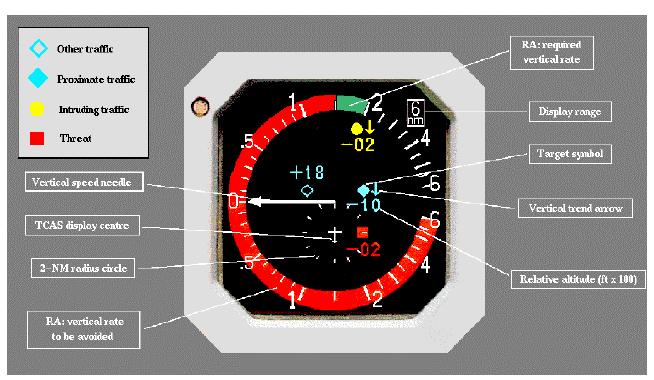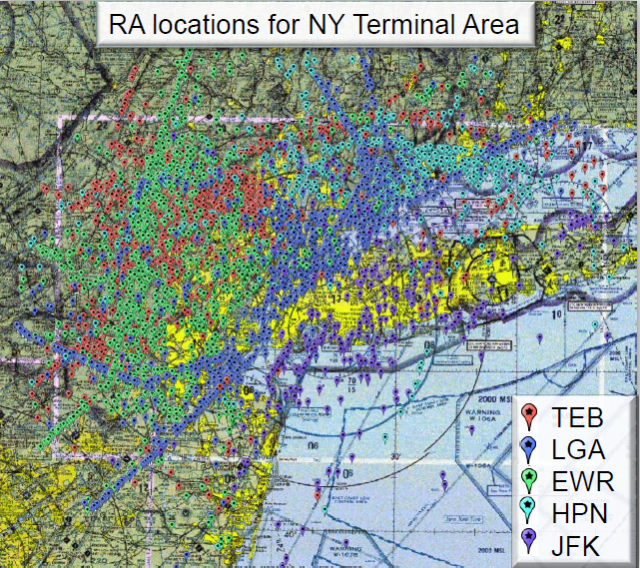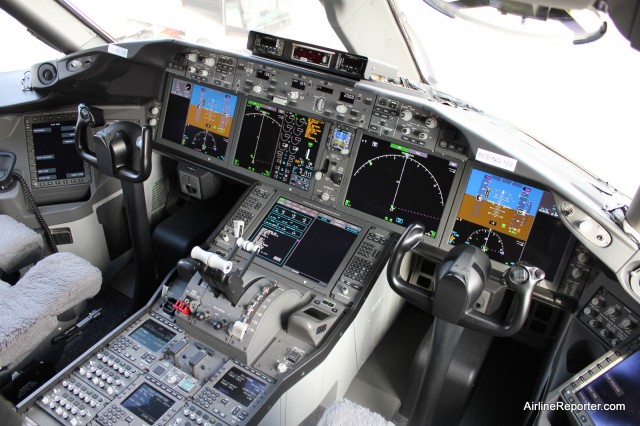
787 cockpit showing TCAS on the Multi-Function Display – Photo: AirlineReporter
A few months ago, a near-collision between two Boeing 757s off the coast of Hawaii was in the headlines. This event was particularly noteworthy because of the emergency descent made by United Airlines Flight 1205, which descended over 600 feet in a matter of seconds, terrifying passengers and sending items flying in the cabin. The pilots on the United flight were alerted to the oncoming traffic, and took action based on their Traffic Collision Avoidance System (TCAS).
History of mid-air incidents and TCAS mandate
Although TCAS systems are a (relatively) recent development in airline cockpits, the need for such systems was recognized long ago. On June 30,1956, a mid-air collision occurred at 20,000 feet between a United Airlines DC-7 and a TWA Lockheed 1049 over the Grand Canyon in northern Arizona. This incident, which resulted in 128 fatalities, served as a wake-up call for the aviation industry. Prior to the collision, ’œbig sky theory’ was the prevailing notion – that two aircraft flying in three-dimensional space were very unlikely to collide. Following this incident (which also led to the creation of the FAA), research began on developing collision avoidance systems.
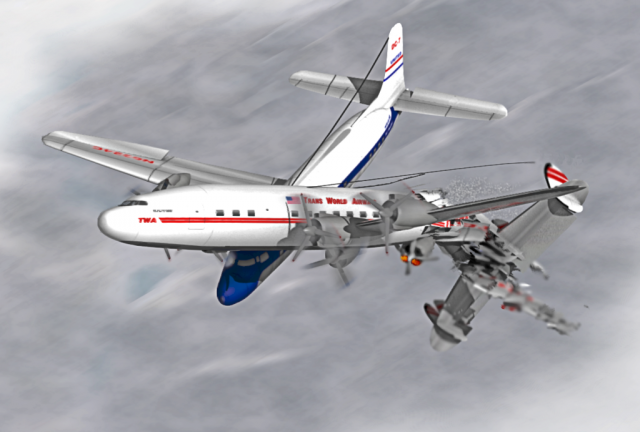
1956 Grand Canyon Mid-Air Collision – Image: Wikipedia (CC BY-SA 3.0)
Although radar-based air traffic control helped to prevent mid-air collisions, incidents continued to occur at a regular rate. On August 31st, 1986, an Aeromexico DC-9 on approach to LAX collided with a Piper PA28, resulting in 82 fatalities (including 15 on the ground). This incident spurred Congress and the FAA to mandate that TCAS systems be installed on all aircraft with over 30 seats (later extended by ICAO to aircraft with more than 19 seats). At the same time, transponders were mandated for all aircraft flying within busy airspace, regardless of size. After several delays, full implementation of the TCAS mandate went into effect on December 31st, 1993.
How it Works
TCAS works together with transponders to identify aircraft that encroach into the airspace surrounding the plane. Notably, TCAS is not radar and will not identify aircraft that do not have functioning transponders.
To understand how TCAS functions, one must first understand how transponders work. Transponders respond to an interrogation signal (at 1030 MHz) with a reply signal (at 1090 MHz). Mode C transponders include the aircraft’s elevation encoded in the reply. Mode S transponders (required for TCAS-equipped aircraft) also transmit additional information about the aircraft’s position, direction, and speed that can be received and interpreted by ATC and other aircraft.
An aircraft’s TCAS system continually pings the airspace in its immediate vicinity to locate other planes, while also listening for mode S transponder signals. Using two directional antennas, the system can determine the direction a transponder reply is coming from. The system determines the distance to the other aircraft by timing the delay between the interrogation signal and response – the shorter the reply time, the closer the other plane is. This information, combined with the other aircraft’s reported altitude, allows the system to build a 3D map of the surrounding airspace and to predict the future locations of other aircraft. Mode S transponder data, when available, is also used to determine a target aircraft’s position, bearing, and velocity.
Traffic Advisories and Resolution Advisories
TCAS systems issue two types of advisories – Traffic Advisories (TA) and Resolution Advisories (RA). TAs are an announcement of nearby traffic, to which the pilots should respond by attempting to visually acquire the target aircraft and make minor course adjustments to minimize the encounter, within the limits of ATC instructions. RAs are instructions issued by the TCAS (climb or descend) which the pilots should immediately follow, disregarding any ATC instructions.
TAs and RAs are both issued based upon the calculated closest point of approach of a nearby aircraft. If the closest point of approach falls within minimum vertical separation (300-700 feet, depending on the altitude) and the threat aircraft is within the advisory envelopes, the system will issue a TA or RA. The TA and RA envelopes are defined in seconds, based on the speed difference between the two aircraft. The TA envelope varies from 20-48 seconds, and the RA envelope is 15-35, depending on the aircraft’s altitude.
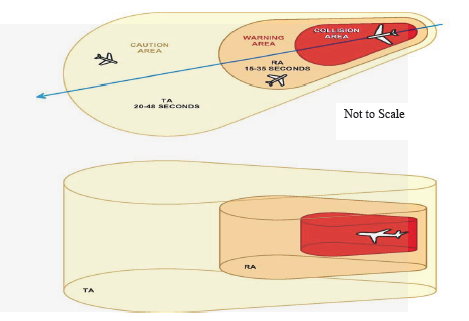
TCAS advisory zones, showing traffic advisory (TA) and resolution advisory (RA) envelopes Image: FAA
For example, for an aircraft flying at 30,000 feet, the TA and RA times are 48 and 35 seconds, respectively. If another aircraft at the same altitude is approaching head on with a speed differential of 1,100 MPH, the horizontal TA envelope is 14.7 miles (48 seconds at 1,100 MPH) and the RA envelope is 10.7 miles (35 seconds at 1,100 MPH). However, if the two aircraft are flying the same direction with much lower closing speeds, the envelopes become much smaller. If the closing speed is only 50MPH, the TA and RA windows are 1.3 and 1.1 miles – the minimum envelope sizes for very slow closing speeds.
A similar calculation is performed for vertical closing speeds. Two aircraft closing on each other at 10,000 feet per minute would have vertical TA and RA envelopes of 5,800 and 8,000 feet, while a closing speed of 500 feet per minute would result in the minimum envelope sizes of 1,200 and 800 feet.
During an RA encounter between two TCAS-equipped aircraft, the TCAS systems utilizes the mode S transponder’s function to coordinate RAs between the two aircraft so that if one aircraft is commanded to descend, the other will be commanded to climb. Newer implementations of TCAS are also able to determine if the other aircraft does not comply with their RA and revise the advisory as needed.
What the Pilots See & Hear
TCAS targets are typically shown on an aircraft’s multi-function display (MFD) along with other navigational information. Targets are shown on the display differently depending on their altitude and threat status.
When a TA is issued, the TCAS will annunciate the advisory (’œTraffic, Traffic’) and the target color will change to yellow on the TCAS display. If an RA is issued, the TCAS system will annunciate the advisory (’œClimb, ’œDescend’, ’œLevel Off’, etc.) and the target will show as red on the TCAS display. In addition to the annunciation and TCAS display, the RA may be shown on the primary flight display.
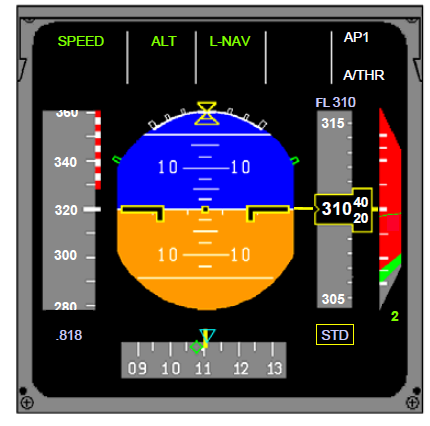
Primary flight display during a TCAS resolution advisory. The reccommended action (descend) is shown in green. – Image: FAA
TCAS Statistics
Although the United 1205 incident received significant media coverage, TCAS advisories are not uncommon. MIT’s Lincoln Laboratory monitors TCAS RAs, via ground-based ADS-B monitoring from downlinks at 21 locations in the United States. From this monitoring, MIT has amassed a database of over 100,000 RAs.
From this monitoring, the MIT team determined that TCAS RAs occur at a frequency between 1 in every 20 flights to 1 in every 550 flights, depending on the airport. RAs are significantly more common at smaller airports than larger airports, and the majority (74%) of intruding aircraft are general aviation aircraft. 82% of all RAs occur below 10,000 feet.
While the MIT study provides some insight into the frequency of TCAS events, many, if not most of these incidents are ’œnuisance’ alerts, for which the intruding aircraft did not pose a threat. NASA’s Aviation Safety Reporting System (ASRS) likely provides a better idea of actual incidents. The ASRS database collects statistics confidentially self-reported by pilots. This database contains 3,175 reports of TCAS RAs.
The NTSB incident database, which lists the most serious, life-threatening incidents includes 126 records that mention the terms ’œresolution advisory’ or ’œTCAS’, including the recent United 1205 incident.
TCAS is just one part of a defense-in-depth approach to eliminating mid-air collisions. TCAS, together with flight planning, assigned flight altitudes, and radar-based air traffic control is responsible for a five-fold decrease in mid-air collisions per flight hour since 1970. This statistic is even more impressive considering airspace became much more crowded, with a four-fold increase in traffic over the same period.
